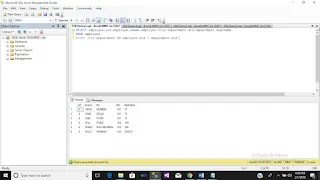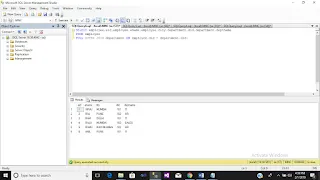Hello Friend Today In This Blog I Will Show You How To Use Different Type Of Mssql Joins .A JOIN clause is used to combine rows from two or more tables, based on a related column between them.The INNER JOIN keyword selects records that have matching values in both tables.The LEFT JOIN keyword returns all records from the left table (table1), and the matched records from the right table (table2). The result is NULL from the right side, if there is no match.The RIGHT JOIN keyword returns all records from the right table (table2), and the matched records from the left table (table1). The result is NULL from the left side, when there is no match.The FULL OUTER JOIN keyword return all records when there is a match in either left (table1) or right (table2) table records.A self JOIN is a regular join, but the table is joined with itself.A SQL JOIN combines records from two tables.A JOIN locates related column values in the two tables.A query can contain zero, one, or multiple JOIN operations.INNER JOIN is the same as JOIN; the keyword INNER is optional.(INNER) JOIN: Select records that have matching values in both tables.LEFT (OUTER) JOIN: Select records from the first (left-most) table with matching right table records.RIGHT (OUTER) JOIN: Select records from the second (right-most) table with matching left table records.FULL (OUTER) JOIN: Selects all records that match either left or right table records.The SQL Joins clause is used to combine records from two or more tables in a database. A JOIN is a means for combining fields from two tables by using values common to each.Here, it is noticeable that the join is performed in the WHERE clause. Several operators can be used to join tables, such as =, <, >, <>, <=, >=, !=, BETWEEN, LIKE, and NOT; they can all be used to join tables. However, the most common operator is the equal to symbol.A SQL Join statement is used to combine data or rows from two or more tables based on a common field between them.INNER JOIN: The INNER JOIN keyword selects all rows from both the tables as long as the condition satisfies. This keyword will create the result-set by combining all rows from both the tables where the condition satisfies i.e value of the common field will be same.LEFT JOIN: This join returns all the rows of the table on the left side of the join and matching rows for the table on the right side of join. The rows for which there is no matching row on right side, the result-set will contain null.RIGHT JOIN: RIGHT JOIN is similar to LEFT JOIN. This join returns all the rows of the table on the right side of the join and matching rows for the table on the left side of join. The rows for which there is no matching row on left side, the result-set will contain null. FULL JOIN: FULL JOIN creates the result-set by combining result of both LEFT JOIN and RIGHT JOIN. The result-set will contain all the rows from both the tables. The rows for which there is no matching, the result-set will contain NULL values.There are four basic types of SQL joins: inner, left, right, and full. The easiest and most intuitive way to explain the difference between these four types is by using a Venn diagram, which shows all possible logical relations between data sets. Let's use the tables we introduced in the “What is a SQL join?” section to show examples of these joins in action. The relationship between the two tables is specified by the customer_id key, which is the "primary key" in customers table and a "foreign key" in the orders table.Let’s say we wanted to get a list of those customers who placed an order and the details of the order they placed. This would be a perfect fit for an inner join, since an inner join returns records at the intersection of the two tables.If we wanted to simply append information about orders to our customers table, regardless of whether a customer placed an order or not, we would use a left join. A left join returns all records from table A and any matching records from table B.Right join is a mirror version of the left join and allows to get a list of all orders, appended with customer information.Finally, for a list of all records from both tables, we can use a full join.A SQL join is a Structured Query Language (SQL) instruction to combine data from two sets of data (i.e. two tables). Before we dive into the details of a SQL join, let’s briefly discuss what SQL is, and why someone would want to perform a SQL join.SQL is a special-purpose programming language designed for managing information in a relational database management system (RDBMS). The word relational here is key; it specifies that the database management system is organized in such a way that there are clear relations defined between different sets of data. Typically, you need to extract, transform, and load data into your RDBMS before you’re able to manage it using SQL, which you can accomplish by using a tool like Stitch.An SQL JOIN clause combines rows from two or more tables. It creates a set of rows in a temporary table.A JOIN works on two or more tables if they have at least one common field and have a relationship between them.JOIN keeps the base tables (structure and data) unchanged.
Different Types of SQL JOINsHere are the different types of the JOINs in SQL:
(INNER) JOIN: Returns records that have matching values in both tablesLEFT (OUTER) JOIN: Return all records from the left table, and the matched records from the right tableRIGHT (OUTER) JOIN: Return all records from the right table, and the matched records from the left table
FULL (OUTER) JOIN: Return all records when there is a match in either left or right table
INNER JOIN Syntax
SELECT column_name(s)FROM table1
INNER JOIN table2 ON table1.column_name = table2.column_name;
LEFT JOIN Syntax
SELECT column_name(s)FROM table1
LEFT JOIN table2 ON table1.column_name = table2.column_name;
RIGHT JOIN Syntax
SELECT column_name(s)FROM table1
RIGHT JOIN table2 ON table1.column_name = table2.column_name;
FULL OUTER JOIN Syntax
SELECT column_name(s)FROM table1
FULL OUTER JOIN table2 ON table1.column_name = table2.column_name;
Step 1 :Create database
Create database BMC
Step 2:Create table
Here In This step We Will Create Two table.
Here In This Step We Required Four Column With Name eid ,ename ,city And did using Parameter bigint and varchar.
create table employee ( eid bigint, ename varchar(25), city varchar(25), did bigint, );
Here In This Step We Required Four Column With Name did and deptname using Parameter bigint and varchar.
create table department ( did bigint, deptname varchar(25)
);
Step 3 :Create Insert Trigger Functionality
Here In This Step We Will Insert Data Using Insert Command.
Data Will Be Added Manually Using Insert Command.
insert into employee values(1,'VIRAJ','MUMBAI',101)insert into employee values(2,'RAJ','PUNE',102)insert into employee values(3,'RAM','DELHI',101)insert into employee values(4,'RAJU','MUMBAI',103)insert into employee values(5,'RAMU','NAVI MUMBAI',102)insert into employee values(6,'ANIL','PUNE',101)
insert into department values(101,'IT')insert into department values(102,'HR')insert into department values(103,'SALES')
select *from employee
select *from department
Step 4 :Use Different Type Of Mssql Joins Functionality.
INNER JOIN
SELECT employee.eid,employee.ename,employee.city,department.did,department.deptnameFROM employee
INNER JOIN department ON employee.did = department.did;
LEFT JOIN
SELECT employee.eid,employee.ename,employee.city,department.didFROM employee
LEFT JOIN department ON employee.did = department.did;
RIGHT JOIN
SELECT employee.eid,employee.ename,employee.city,department.did,department.deptnameFROM employee
RIGHT JOIN department ON employee.did = department.did;
FULL OUTER JOIN
SELECT employee.eid,employee.ename,employee.city,department.did,department.deptnameFROM employee
FULL OUTER JOIN department ON employee.did = department.did;
Here Is An Video Related To Topic In This Blog






